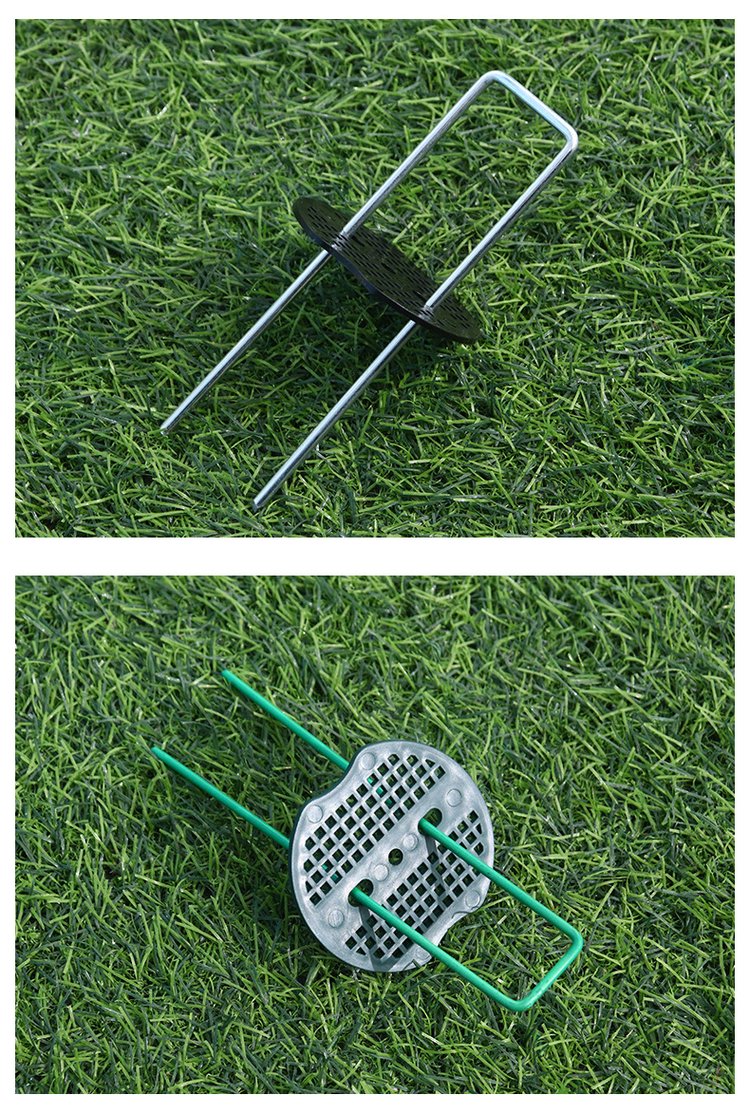Landscape fabric staples, also known as garden staples or U - stakes, are essential tools in gardening and landscaping projects. These simple yet highly effective fasteners play a crucial role in maintaining the functionality and aesthetics of outdoor spaces. In this article, we will explore what landscape fabric staples are, their various types, how to use them, and most importantly, their diverse applications.
Landscape fabric staples are typically U - shaped fasteners made from materials such as galvanized steel, stainless steel, or durable plastic. The U - shape design allows them to have two pointed ends that can easily penetrate the soil, while the curved top provides stability and resistance against being pulled out. Their length can vary from 2 to 10 inches, with different lengths serving different purposes. Shorter staples are suitable for lightweight tasks, while longer ones offer greater holding power for more heavy - duty applications.
Galvanized Steel Staples: These are one of the most popular choices due to their excellent durability and rust - resistance. Galvanized steel staples can withstand harsh outdoor conditions, including exposure to moisture, sunlight, and varying temperatures. They are ideal for long - term landscaping projects where a high level of strength and stability is required.
Stainless Steel Staples: Offering superior corrosion resistance compared to galvanized steel, stainless steel staples are perfect for areas with high humidity or near saltwater, such as coastal gardens. Although they tend to be more expensive, their longevity and strength make them a worthy investment for certain applications.
Plastic landscape fabric staples are lightweight, cost - effective, and easy to install. They are a great option for less demanding tasks, such as securing lightweight landscape fabric or edging in a small garden. While they may not be as durable as metal staples, they are suitable for temporary or short - term projects and are an eco - friendly choice as many are made from recyclable materials.
Using landscape fabric staples is a straightforward process. For soft soil, you can usually push the staples into the ground by hand, making sure that both pointed ends are fully inserted. In the case of harder soil, a rubber mallet or a small hammer can be used to gently tap the top of the staple until it is firmly embedded in the ground. It's important to ensure that the staple is driven in straight to maximize its holding power. The spacing between staples depends on the application; for example, when securing landscape fabric, they are typically placed every 12 - 18 inches.
One of the primary and most common uses of landscape fabric staples is to hold down landscape fabric. Landscape fabric, also known as weed control fabric, is widely used in gardens, flower beds, and pathways to suppress weed growth, retain soil moisture, and maintain soil structure. By using landscape fabric staples to secure the fabric at regular intervals, you prevent it from shifting, wrinkling, or being lifted by wind or animals. This ensures that the fabric remains effective in its functions, keeping your garden looking neat and reducing the need for frequent weeding.
Landscape fabric staples are invaluable for securing various types of edging materials. Whether it's plastic, rubber, metal, or stone edging used to define garden beds, separate pathways from lawns, or create decorative borders, staples keep the edging in place. This not only enhances the aesthetic appeal of your landscape by creating clean, defined lines but also prevents the edging from moving or sinking over time, ensuring long - term stability and functionality.
In some gardening scenarios, landscape fabric staples can be used to provide support for young plants or vines. Shorter staples can be gently pushed into the ground near the base of the plant to hold down flexible supports like garden twine or mesh, guiding the growth of the plant and protecting it from being damaged by wind or other external forces. This is especially useful for newly planted seedlings or delicate climbing plants that need assistance in establishing their growth direction.
When applying mulch, straw, or other ground covers in your garden, landscape fabric staples can help keep them in place. This is particularly important on sloped areas where these materials might otherwise slide or wash away during rain or wind. By securing the edges of the mulch or ground cover with staples, you maintain an even layer, which helps to retain soil moisture, regulate soil temperature, and suppress weed growth more effectively.
In outdoor electrical or irrigation setups, landscape fabric staples can be used to keep cables, wires, and hoses in place. This prevents them from being accidentally pulled or damaged, ensuring the proper functioning of your garden's electrical and watering systems. By securing these elements with staples, you also keep your garden looking tidy and organized, avoiding tripping hazards and potential damage to the equipment.
In conclusion, landscape fabric staples are a versatile and indispensable tool in the world of gardening and landscaping. Their ability to securely fasten a variety of materials makes them essential for maintaining the beauty and functionality of outdoor spaces. Whether you're a professional landscaper or a passionate home gardener, understanding the uses and benefits of landscape fabric staples can greatly enhance the success of your projects. So, the next time you embark on a gardening or landscaping endeavor, don't forget to have a supply of these handy fasteners on hand.